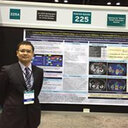A phase I study of the combination of panitumumab and bevacizumab in KRAS wild-type colorectal cancer patients previously treated with fluoropyrimidine, oxaliplatin, irinotecan and bevacizumab.
الكلمات الدالة
نبذة مختصرة
OBJECTIVE
The clinical benefit of combination treatment with panitumumab and bevacizumab (PB) based on bevacizumab beyond progression (BBP) after the failure of second-line chemotherapy remains unclear. We assessed the tolerability and efficacy of PB as BBP in Japanese patients with metastatic colorectal cancer (mCRC).
METHODS
This phase I study comprised two parts: (1) PB part to estimate the recommended PB dose, (2) CPB part to investigate the safety of PB with irinotecan (CPB). Three panitumumab doses (4, 5, and 6 mg/kg at Levels -1, 0 and 1, respectively) were set for the PB part, starting with Level 0. Bevacizumab was administered at a fixed dose of 5 mg/kg, regardless of panitumumab dose levels. All drugs were administered on day 1 and repeated every 2 weeks.
RESULTS
No dose-limiting toxicities were observed at Levels 0 (n = 3) and 1 (n = 3) for the PB part, determining the recommended dose as Level 1. During the whole treatment course at Level 1, grade 3 acneiform rash was observed in two patients with a partial response. For six patients (irinotecan biweekly, 150 mg/m(2) n = 3, 120 mg/m(2) n = 3) enrolled in the CPB part, grade 3 toxicities were leukopenia/neutropenia (n = 1), mucositis (n = 1), diarrhea (n = 1), rash acneiform (n = 1) and thromboembolic event (n = 1), and two of six patients achieved partial responses.
CONCLUSIONS
Recommended doses for the PB regimen in mCRC were panitumumab 6 mg/kg and bevacizumab 5 mg/kg. PB and CPB showed manageable toxicities in KRAS wild-type patients previously managed with standard treatment, including bevacizumab.





